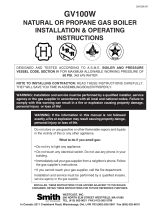
GS110 DIRECT VENT BOILER INSTALLATION AND OPERATION INSTRUCTIONSPage 4
All Combustion Air From Inside The Building
Older houses often have enough “leakage” to provide
an adequate amount of combustion air provided that the
demand for combustion air is not too great, Figure 3.
Homes that are relatively new or “tight” will most likely
require that the combustion be ducted to the boiler from
outside the building. Any home utilizing other gas
burning appliances, a fireplace, wood stove or any type
of exhaust fan must be checked for adequate
combustion air when all of these devices are in
operation at one time.
If the boiler is to be located in an alcove, closet or other
confined space the distances from the boiler and it's
vent system to all-combustible construction must be
equal to or greater than the minimum clearances in
Figure 1. When installed in a closet or confined space
two permanent openings of equal area adjoining another
room or rooms having sufficient volume to meet the
requirements of an unconfined space must be provided,
Figures 4 & 5. Each opening must have a minimum free
area of one square inch per 1000 Btu/hr (2200 mm
2
/
kW) based on the total input rating of all gas utilization
equipment in the confined area. Each opening must be
no less than 100 square inches (64516 mm
2
) in size.
The upper opening must be within 12 inches (305 mm)
of, but not less than 3 inches (76 mm) from, the top of
the enclosure. The bottom opening must be within 12
inches (305 mm) of, but not less than 3 inches (76 mm)
from, the bottom of the enclosure.
All Combustion Air From Outside The Building
When installed in a confined space without the intake
air option two permanent openings communicating
directly with, or by ducts to, the outdoors or spaces that
freely communicate with the outdoors must be present.
The upper opening must be within 12 inches (305 mm)
of, but not less than 3 inches (76 mm) from, the top of
the enclosure. The bottom opening must be within 12
inches (305 mm) of, but not less than 3 inches (76 mm)
from, the bottom of the enclosure.
Where directly communicating with the outdoors or
communicating with the outdoors through vertical ducts,
each opening shall have a minimum free area of 1 in
2
/
4000 Btu/hr (550 mm2/kW) of the total input rating of
all of the equipment in the enclosure.
Where communicating with the outdoors through hori-
zontal ducts, each opening shall have a minimum free
area of 1 in
2
/2000 Btu/hr (1100 mm
2
/kW) of the total
input rating of all of the equipment in the enclosure.
When ducts are used, they must have the same cross-
sectional area as the free area of the opening to which
they connect. Sizing of an outside air duct must be
based on the total input rating of all gas utilization
equipment in the confined space.
COMBUSTION AIR & VENTILATION
WARNING: This boiler must be supplied with
combustion air in accordance with Section 5.3,
Air for Combustion & Ventilation, of the latest
revision of the National Fuel Gas Code, ANSI
Z223.1/NFPA 54 and all applicable local building
codes. Canadian installations must comply with
CSA B149.1 or .2 Installation Code for Gas
Burning Appliances and Equipment, or
applicable provisions of the local building
codes. Failure to provide adequate combustion
air for this boiler/water heater can result in
excessive levels of carbon monoxide which can
result in severe personal injury or death!
To operate properly and safely this boiler requires a
continuous supply of air for combustion. NEVER store
objects on or around the boiler!
CAUTION: Combustion air contaminated with
fluorocarbons or other halogenated compounds
such as cleaning solvents and refrigerants will
result in the formation of acids in the combustion
chamber. These acids will cause premature failure
of the boiler voiding the warranty!
CAUTION: If the boiler is operated while the building
is under construction it MUST be protected from
wood, concrete, sheet rock and other types of dust.
Failure to properly protect the unit from
construction dust will damage the unit voiding the
warranty!
Buildings may require the installation of a fresh air duct
or other means of providing make-up air if the intake
air option isn't used. Any building utilizing other gas
burning appliances, a fireplace, wood stove or any type
of exhaust fan must be checked for adequate
combustion air when all of these devices are in
operation at one time. Sizing of an outside air duct must
be done to meet the requirements of all such devices.
WARNING: Never operate this boiler in an
environment subjected to a negative pressure
unless the air intake is connected to the
outdoors. Failure to comply with this warning
can result in excessive levels of carbon
monoxide causing severe personal injury or
death!

























